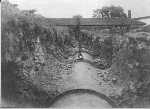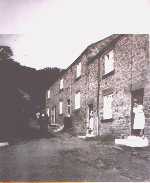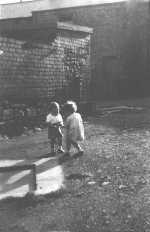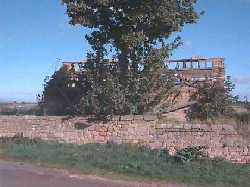WATER SUPPLIES
In the early years the village water supply was drawn from wells, positioned
at various locations around the village, and the occasional spring. Wells, fitted
with hand pumps were to be found beside the rear of Carter's Cottages and in
Kennel Yard. Chare Well, was situated at the foot of Chare Bank, opposite the
east end entrance to the Memorial Park.
A spring also flowed out on the north side of the Common, on the edge of
the Hexham road.
The house to the right of the entrance to the church, Church House, had a
well situated inside the house. This was eventually condemed when it was realised
that the water was first passing through the churchyard behind the house
(Click the image to see a larger
version)
|
In the middle of the eighteen hundreds a water tank was sunk into the solid
rock and housed in a stone building, on the site of the 12th milecastle,
near Town Farm yard, just to the west of Amos Bros workshops. This tank then
fed a series of communal taps around the village
The tank was fed from the Seven Springs, that rise in a deep ravine on the
west side of the East Heddon estate,by a pump and pipes installed in the
Mill House, (location of the Mill
House) which was situated on the left side of the by-pass, as you travel
east, just after the point where the slip road joins the by-pass. |
 |
The photo above shows a 42" main pipe being laid in a trench to supply
the village (circa 1890).
|
(Click the image to see a larger
version)
|
The photo on the left shows Mushroom Row cottages, and on the skyline in
the centre of the picture, you can just make out the outline of the water
storage tank, on the top of the hill.
The storage tank had a float inside, which was attached to a long pole with
a flag on top, this enabled the level of the water in the tank to be clearly
visible from a distance.
If you click on the photo, to view the larger version of the image, you can
just make out the flag, above the water tank. |
 |
The task of ensuring that the water tank remained at a reasonable level belonged
to a council employee, who living in the first cottage on the right as you
travel up to East Heddon, as he was very close to the brick building which
housed the pump and engine. He reputedly used a pair of binoculars to check
the height of the flag ,morning and night, and started or stopped the engine
accordingly.
After the water tank was installed the supply to the village consisted of
five stand pipes, where people collected their water in pails, They were
at:
1. Knott Memorial Hall
2. Carter's Cottage
3. Mushroom Row
4. Between Clayton Terrace and Blue Row
5. Square Yard
Plus the spring on the Common
The photo on the right shows the "Square Yard" (circa 1954/55), in the background
you can see one of the five communal taps in the village. |
(Click the image to see a larger
version)
|
 |
The supply was still haphazard with frequent breakdowns leaving the village
without water for three or four days at a time. The unreliability of the
supply was a barrier to the installation of hot water systems and flush toilets.
This lack of reliability of supply was refered to in the minutes of a meeting
of the Parish Council held on the 10th November, 1930, when Mr. Anderson
drew attention to the Water supply at the tap near the Square Yard stating
that it took over an hour to get a pailfull. It was proposed that Mr. Hedley
be written to by the Clerk drawing his attention to the inadequate supply
at the tap and asking him to give it his attention as soon as possible.
Again, at another meeting on the 13 April, 1931, Mr. Hunter asked if anything
could be done to get a better supply of water for the Parish. After considerable
discussion it was decided that Mr. Taylor would interview Mr. Horton, Newcastle
Water Works, as to terms for supplying the Parish. The Clerk to ask Mr. Jameson,
Sanitary Inspector Rural District Council to attend the next meeting.
Eventually the Rural District Council, around 1934, took steps to remedy
the situation by obtaining a loan from the Ministry of Health and installing
a new pump and laying a new pipe to a new iron tank, installed near the
churchyard. A new three inch main pipe was also laid around the village.
Around 1954 the supply of water was taken over by the Newcastle and Gateshead
Water Co and water was then piped directly in, from the Whittle Dene reservoir,
to feed the village mains, the spring supply ceased to be used. |
Tank house near churchyard
(Click the image to see a larger version)
|
 |



